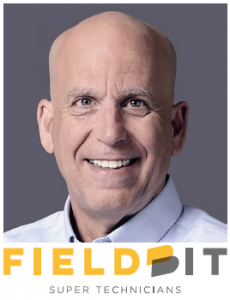In this the final week of the first edition of our new series "The Big Discussion" we've now looked at three key questions on the important topic of Augmented Reality.
ARCHIVE FOR THE ‘niklas-rengfors’ CATEGORY
Jun 12, 2017 • Features • Augmented Reality • Future of FIeld Service • Niklas Rengfors • XM reality • Big Debate • David Nedohin • Evyatar Meiron • FieldBit • ScopeAR
In this the final week of the first edition of our new series "The Big Discussion" we've now looked at three key questions on the important topic of Augmented Reality.
The idea behind this new series is that we take one topic, bring together three leading area experts and put four key questions to them across four weeks, to help us better understand its potential impact on the field service sector...
Our first topic has been Augmented Reality and our experts are Evyatar Meiron, CEO, Fieldbit, Niklas Rengfors, Head of Sales & Marketing, XM Reality and David Nedohin, President, ScopeAR...
So far we've asked our panel:
"Just how big an impact can and will Augmented Reality have on field service delivery?" ,
"What advantages does Augmented Reality offer over video calls such as FaceTime and Skype etc?" and
and now onto our final question in our Augmented Reality Big Discussion...
Question Four: How closely tied to the development of smart glasses is augmented reality – are the two co-dependent or are tools on smartphones/tablets sufficient?
 David Nedohin, President, ScopeAR
David Nedohin, President, ScopeARMany visualise the ability to have a hands-free environment, where AR information shows up in front of them through smart glasses. However, very few enterprises have yet to adopt and deploy smart glasses, including devices such as Microsoft’s HoloLens, ODG’s R7 or RealWear, at scale. Although these glasses are advancing quickly. adoption of wearables in today’s market can be hindered by price, production and specific product limitations depending on the environment and user.
While hardware manufacturers continue to address these challenges, field workers are starting to reap the benefits of augmented reality using the hardware (smartphones/tablets) currently available to them, and most importantly, that they are comfortable with, while exploring glasses.
With so many AR tools available on today’s smartphones and tablets, enterprises are already realising success without having to make an additional investment in new hardware. With the addition of depth cameras and new computer vision techniques, handheld devices are becoming more and more practical.
 Evyatar Meiron, CEO, Fieldbit
Evyatar Meiron, CEO, FieldbitSmart glasses are poised to take the world by storm. Leading smart glasses companies (including Microsoft) have already invested billions of dollars in design and development. Clearly, augmented reality is a key driver behind the development of smart glasses.
With respect to field services, it’s important to remember that we’re still at a very early stage. Most smart glasses on the market today cannot support all field service needs. The decision on whether to use smart glasses or a smartphone depends on the industry segment and the use case. For example, when working with ink-filled printing systems or in high-voltage environments, smart glasses are critical for enabling hands-free collaboration.
Another key advantage of smart glasses is that they enable both augmented reality and mixed reality. A hybrid of augmented and virtual reality, mixed reality enables users to overlay digital content onto a realtime physical space in 3D mode for highly realistic interactions.
 Niklas Rengfors, Head of Sales & Marketing, XM Reality
Niklas Rengfors, Head of Sales & Marketing, XM RealityDevelopment of smart glasses are important but not crucial. For XMReality with core focus on customers within industrial field service, hands-free options, like glasses working in rough environment is something there is a demand for.
However our customers struggle a bite on how to use glasses, there are also so many different preferences on what you like, monocular, binocular so smartphones/tablets are sufficient in most cases and also something one in general carries.
For us it is important to get an understanding on the customers use cases, to recommend what would be their best choice to use.
The next instalment of The Big Discussion will be focussed on the topic of IoT and Servitization is coming soon...
Be social and share this feature
Jun 05, 2017 • Features • Augmented Reality • Future of FIeld Service • Niklas Rengfors • XM reality • Big Debate • David Nedohin • Evyatar Meiron • FieldBit • ScopeAR
As we move into week three of our new series we've now addressed a couple of big questions around the core topic of Augmented Reality.
As we move into week three of our new series we've now addressed a couple of big questions around the core topic of Augmented Reality.
The series is called The Big Discussion and the idea is that we take one topic, bring together three leading experts on that topic and put four key questions to them across four weeks, to help us better understand its potential impact on the field service sector...
On this first topic of Augmented Reality and our experts are Evyatar Meiron, CEO, Fieldbit, Niklas Rengfors, Head of Sales & Marketing, XM Reality and David Nedohin, President, ScopeAR...
So far we've asked our panel "Just how big an impact can and will Augmented Reality have on field service delivery?" and "What advantages does Augmented Reality offer over video calls such as FaceTime and Skype etc?"
and now onto this weeks question in the Big Discussion...
Question Three: Do you see Augmented Reality ultimately becoming a standard tool included within wider FSM solutions or should it be viewed as a specialist standalone application?
 David Nedohin, President, ScopeAR
David Nedohin, President, ScopeARAugmented reality is a communication technology that will be integrated into FSM tools and made available to the workforce to access when and where they need it.
This may be required to meet government regulations, to engage with an expert, or improve competency or safety.
However, AR will be a tool in the toolkit that will be used when needed, and part of a larger set of technologies.
If a picture, voice call or video is appropriate, perhaps AR will not be needed, but as workers become more familiar with the value of AR once integrated into their FSM apps, it will be a tremendous resource, when it is needed.
 Evyatar Meiron, CEO, Fieldbit
Evyatar Meiron, CEO, FieldbitAs mentioned earlier, augmented reality is a disruptive technology that is radically changing the way organisations perform field service maintenance. It is an innovative platform that uses new technologies.
For this reason, augmented reality is more likely in the short term to remain a standalone tool that complements FSM solutions. That said, some of the more basic telesupport-oriented augmented reality features - those that enable real-time remote communications between the onsite technician and the expert at company headquarters - could be integrated at some point with the FSM software.
In contrast, the knowledge management component, including the information capture, storage, sharing and search capabilities, is more complex in nature and requires specific expertise. I believe that this component will continue to develop as a separate specialist system.
 Niklas Rengfors, Head of Sales & Marketing, XM Reality
Niklas Rengfors, Head of Sales & Marketing, XM RealityDefinitely included within wider FSM solutions, we are currently working with different partners already, IFS to mention one is strong partner in field service.
By connecting information flows between systems for example between mobile work orders and XMReality, it adds a lot of value to the customer.
Can be things like storing for documentation purposes, saved videos later then used for training purposes etc. As solutions to display or create content gets more efficient AR will most likely become a standard tool.
Next weeks the final question: How closely tied to the development of smart glasses is augmented reality – are the two co-dependent or are tools on smartphones/tablets sufficient?
May 24, 2017 • Features • Augmented Reality • Future of FIeld Service • Niklas Rengfors • XM reality • Big Debate • David Nedohin • Evyatar Meiron • FieldBit • ScopeAR
Last week we launched a new feature called the Big Discussion where we take one topic, bring together three leading experts on that topic and put four key questions to them across four weeks, to help us better understand its potential impact on the...
Last week we launched a new feature called the Big Discussion where we take one topic, bring together three leading experts on that topic and put four key questions to them across four weeks, to help us better understand its potential impact on the field service sector...
Our first topic is Augmented Reality and our experts are Evyatar Meiron, CEO, Fieldbit, Niklas Rengfors, Head of Sales & Marketing, XM Reality and David Nedohin, President, ScopeAR...
Last weeks question was Just how big an impact can and will Augmented Reality have on field service delivery? Check out our panel's answers here if you missed them
and now onto next weeks question in the Big Discussion
Question Two: What advantages does Augmented Reality offer over video calls such as FaceTime and Skype etc?
 David Nedohin, President, ScopeAR
David Nedohin, President, ScopeARUnlike a video call, augmented reality offers the ability to overlay specific content (animated instructions, annotations, drawings, 3D content, graphics, text, etc.) onto the real-world and have it “stick” to the part or area being referenced. Using AR, field workers can visualise content, such as predefined instructions, on top of a piece of equipment they’re assembling or repairing to show exactly the right steps, regardless of previous training.
Another advantage that AR presents is that it facilitates more efficient and effective knowledge transfer from a subject matter expert in real-time -- who may be located at the company’s headquarters or a call center -- to the remote worker. With an AR-enabled video calling platform, an expert can collaborate with a colleague out in the field, seeing what they’re seeing in real-time and simulate an “over-the shoulder” view of having someone walk the field worker through the correct procedure.
For example, while viewing a live video stream of a machine undergoing maintenance, an expert could use augmented reality to circle a bolt in real-time and tell the technician in the field to remove it. And with today’s AR technology, the correct bolt would stay circled even as the technician moves around, allowing for an unprecedented level of interaction between the expert and technician. Instead of just “telling” a worker how to do something, the expert can now “show” them and then document that conversation.
 Evyatar Meiron, CEO, Fieldbit
Evyatar Meiron, CEO, FieldbitReal-time video can be useful for remote diagnostics, allowing the technician to transmit video from the faulty machine to an expert off-site. Effective field service, however, requires two-way data transfer beyond the capabilities of video.
Augmented reality allows the flow of knowledge from the expert to the technician or user on site. It enables the quick addition of context-sensitive information, such as text annotations, diagrams and other messages, on top of the live video so technicians can zero in on how to fix the machine.
Another key advantage is knowledge capture. Advanced augmented reality platforms, such as Fieldbit, accumulate practical knowledge related to service and repair processes by recording all actions and information exchanged between experts and the field technician.
All visual records, including augmented reality, are stored and are retrievable from a central repository, allowing information to be shared and re-used across the organisation.
 Niklas Rengfors, Head of Sales & Marketing, XM Reality
Niklas Rengfors, Head of Sales & Marketing, XM RealityAt XMReality we are focusing on industrial users and field service. We have taken experience and put it into features that match customer needs.
We have seen impacts on our low bandwidth functionality and also since we add AR, problems are solved quicker and more efficient and more accurate.
The customisation and integration part we offer also comes into play our discussions with our customers.
Next weeks question: Do you see Augmented Reality ultimately becoming a standard tool included within wider FSM solutions or should it be viewed as a specialist standalone application?
Be social and share this feature
May 17, 2017 • Features • Augmented Reality • Future of FIeld Service • Niklas Rengfors • XM reality • Big Debate • David Nedohin • Evyatar Meiron • FieldBit • ScopeAR
In a new series of features we will take one topic, bring together three leading experts on that topic and put four key questions to them across four weeks, to help us better understand its potential impact on the field service sector...
In a new series of features we will take one topic, bring together three leading experts on that topic and put four key questions to them across four weeks, to help us better understand its potential impact on the field service sector...
Our first topic is Augmented Reality and our experts are Evyatar Meiron, CEO, Fieldbit, Niklas Rengfors, Head of Sales & Marketing, XM Reality and David Nedohin, President, ScopeAR...
Question One: Just how big an impact can and will Augmented Reality have on field service delivery?
 David Nedohin, President, ScopeAR
David Nedohin, President, ScopeARMany analyst firms forecast that the AR market will continue its rapid growth, reaching upwards of $140 billion in just a few years. The impact augmented reality can have on field service specifically is unprecedented as it pertains to training, equipment maintenance or repair and knowledge transfer.
For the first time, augmented reality is allowing field workers to take advantage of the power of computers and interact with them in the real world -- moving from a two dimensional screen to seeing information locked on top of the image of the equipment in the real-world and in real-time. I believe AR will be the user interface of the future, making all of a company’s information, intelligence and analytics actionable, by overlaying content directly on top of the real world - when and where a worker needs it most.
The reason that field service industries will lead in benefitting from AR is due to a combination of an ageing workforce that is retiring at staggering rates, and a younger workforce that changes positions quicker than ever.
Expert knowledge is difficult to retain and even more difficult to get into the hands of those in the field without significant delays and expense. AR allows organisations to retain their experts without sending them into the field, while being able to rapidly leverage and measure the expertise they have by putting it right in the hands of the worker who needs it. Augmented reality is enabling “on-demand knowledge transfer.”
 Evyatar Meiron, CEO, Fieldbit
Evyatar Meiron, CEO, FieldbitAugmented reality is changing the way people live, work and interact with one another. The introduction of augmented reality for field service represents nothing less than a seismic shift. The magnitude of its potential impact is comparable to the impact that personal computers had on office workers.
FSM solutions address the communication and workflow needs of service managers, allowing them to tell technicians where to go, what problem needs to be fixed, and which spare part to use. Augmented reality platforms complement FSM by telling the technician how to fix the problem.
This was the missing link.
With this capability, enterprises will be able to drastically boost the productivity and efficiency of their field service operations.
Using augmented reality, technicians can receive precise visual instructions from remote experts to execute complex machinery fixes. Not only does this increase first time fix rates, it also relieves mental stress since technicians can enjoy “over-the-shoulder” coaching throughout the process.
 Niklas Rengfors, Head of Sales & Marketing, XM Reality
Niklas Rengfors, Head of Sales & Marketing, XM RealityWe believe it has a big impact already today, business cases show unreal savings by making the field service delivery more efficient, due to less travelling, increased uptime etc.
We also see big drivers at customers in being able to deliver more profitable service offerings and in the end gain more satisfied customers.
Next weeks question: What advantages does Augmented Reality offer over video calls such as FaceTime and Skype etc?












 Field Service News is published by 1927 Media Ltd, an independent publisher whose sole focus is on the field service sector. As such our entire resources are focused on helping drive the field service sector forwards and aiming to best serve our industry through honest, incisive and innovative media coverage of the global field service sector.
Field Service News is published by 1927 Media Ltd, an independent publisher whose sole focus is on the field service sector. As such our entire resources are focused on helping drive the field service sector forwards and aiming to best serve our industry through honest, incisive and innovative media coverage of the global field service sector.
Leave a Reply